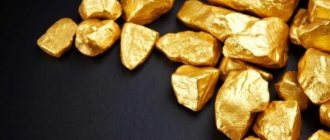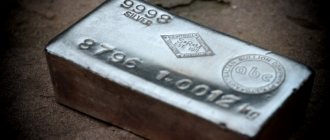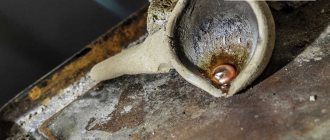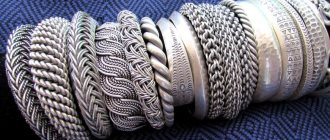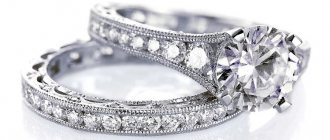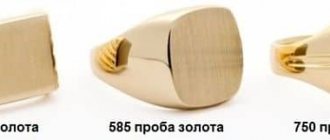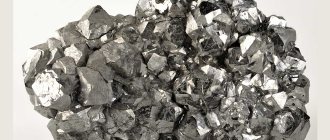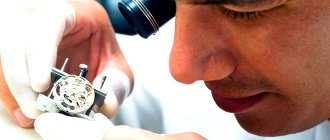Curious readers, hello. I’ll start with a riddle: “What is harder than gold and heavier than steel?” That's right, we're talking about noble silver. I will tell you why it is so important to know the density of silver in this article. The review contains the main characteristics of this rare element of the periodic table, useful information on testing and accessible tips for determining density.
Metal in nature
More than 6 thousand years ago, the first silver products began to be made in the Middle East. And when alloyed with gold, it served as the material for the world’s first coins. And for many centuries it has been valued by jewelers for its high quality, ease of processing and appearance.
Found in nature in nuggets. The largest nugget to date was found in Canada. Its length was 30 meters, and when melted down, 20 tons of metal were obtained. Unfortunately, the chemical activity of this metal allows it to be found only in the form of compounds, often they are silver salts, which contain selenium, sulfur, or other chemical elements. Metal reserves in the world today amount to about half a million tons, and the largest quantities are mined in Peru, China, Mexico, Australia and Chile.
origin of name
If we talk about the name in more detail, then everything is not as simple as mentioned above. Not only in the Proto-Slavic dialect there was a word similar to the modern “silver”. The discovery of specialists showed that similar words exist in the Anatolian group of languages, in languages common in the Middle East, as well as in pre-Indo-European languages of European countries.
It is very difficult, if not impossible, to establish the degree to which a word belongs to a particular culture. There is also a Greek word for silver, árgyros, from which comes the Latin argentum, adopted by the international community as the main name in the international system and periodic table.
Properties of noble metal and its alloys
In its pure form, silver is a refractory, very ductile metal. From one kilogram you can get a wire 2 km long. It does not oxidize under the influence of oxygen, which is why it is classified as a noble metal. However, it interacts with sulfur and iodine, which form a dark film on the surface, which is why silver jewelry requires maintenance.
Silver density depending on brand
The metal lends itself well to processing. It can be easily polished, cut, twisted, drawn and rolled. These properties make it suitable for jewelers, but limit the shelf life of the products. Therefore, it is not used in its pure form; copper is added to give the products strength.
925 silver is called sterling silver. Traditional, with the addition of a small amount of copper, almost pure, is considered ideal for making dishes and jewelry. Experiments with the addition of various metals, including silicon, zinc, germanium and even platinum, could not surpass its qualities.
Pure silver is a heavy metal. It has the highest electrical and thermal conductivity of all known metals.
Basic properties:
- the lowest melting point of all precious metals;
- inertness - does not interact with almost any other substances;
- insoluble in acid, except nitric, sulfuric acid and mercury;
- among precious metals it has the greatest ability to undergo chemical reactions.
It does not dissolve in aqua regia, unlike platinum and gold.
An alloy is a combination of pure silver with other metals to improve its certain characteristics. Various alloys are added to silver. Each state has its own documents regulating the amount of impurities, their type and the content of pure metal in each sample. Based on its content in products, the following samples are distinguished:
| Try | Share of silver and copper, % | Density g/(cm^3) |
| Ag | Cu | Rest |
| 800 | 80 | 10.12 |
| 830 | 83 | 10.18 |
| 875 | 87.5 | 10.27 |
| 925 | 92.5 | 10.36 |
| 960 | 96 | 10.43 |
Features of different alloys used in jewelry:
- 960 sterling silver - similar in properties to pure silver. Used for forging and filigree work. It has low mechanical properties and is easily deformed.
- 925 alloy is standard silver. It is characterized by high compliance and stability in operation. Most often used in jewelry.
- 875 alloy - suitable for casting, soldering, bending, forging. The lowest standard that can be used in jewelry. However, it is not popular because it has a yellowish tint.
- 830 test - a hard alloy, used in casting, difficult to machine. Used in industry or in the manufacture of services.
- 800 standard - used for making cutlery, has a yellowish tint and oxidizes quickly. Has the best casting properties.
Silver is a currency metal; bullions are poured from it, which are purchased and sold in a bank at the exchange rate established for today. For production needs, and the metal is used in a wide range of areas, ingots weighing 20 kg are cast. A silver bar is much smaller in volume than a gold bar. There are also round bars with a denomination of 5 US dollars and the highest purity of all - 99.9%.
Silver bars
Let's sum it up
People always ask me how to tell if silver is real or fake. After reading this review, you learned, dear readers, that silver is extremely thermally conductive, so you can use a simple method - put it in boiling water (if the product does not have stones). It will heat up instantly, but will cool down just as quickly, unlike a fake.
This is important to know, since you should only buy real, high-quality products.
Silver alloys are in demand both in the jewelry industry and in medicine due to their antimicrobial effect; in nanotechnology, in microelectronics (don’t forget that this metal is an excellent conductor). This is a natural, exhaustible resource with a lot of special properties. Share this information on social networks, subscribe to us to learn new and useful information. See you soon!
Source
Impurities in silver alloys
Almost every metal in nature has some impurities in its composition. Their presence affects many physical characteristics, for example, density, and, accordingly, the cost of the metal. In silver the following impurities have the following effect:
- Nickel - a nickel content of less than 1% in an alloy increases the density of the alloy, more than 2.5% makes the metal too brittle.
- Lead is considered a harmful alloy, the presence of which is avoided. When the lead concentration is more than 0.05%, it affects silver, making it more brittle when heated.
- Tin - in small quantities, tin reduces the melting point of the alloy; more than 9% makes silver very brittle.
- Aluminum - up to 5% aluminum may contain a pure metal alloy. A larger amount increases the brittleness and brittleness of the alloy.
- Zinc and cadmium are added to silver to make solder. They are used for soldering and repairing silver products - they lower the melting point of the alloy, thereby helping the solder penetrate the pores of the parts being fused. Zinc should contain no more than 20%, otherwise the product will become brittle.
- Silicon - no more than 1.5% dissolves in the metal; a larger amount also makes the alloy weak.
- Carbon is considered a harmful impurity; it makes the metal brittle and does not dissolve in it. They try to completely remove it.
- Phosphorus and sulfur make it dull and brittle. Alloys containing these elements are poorly suited to electroplating.
The process by which silver is purified industrially is called electrorefining. The method involves suspending the metal in an electrolytic bath containing silver nitrate. Silver with impurities is used as the cathode, and pure metal or titanium sheets serve as the anode. The cathode and anode spaces are separated by fiberglass, which retains sludge. Electrolysis is carried out at a voltage of 2-5 volts. The purified metal remains as is on the cathode.
World deposits
Silver is mined from fundamentally different types of deposits. There are only two such types. They are divided as follows:
- Directly silver deposits. If you process all the mined ore, then more than 50% of the cost of all elements will be allocated to silver.
- Deposits where polymetallic ores are mined. The extracted rock contains several metals at once. Among them, silver accounts for no more than 15% of the total final price.
The world receives only 25% of silver from the first type of deposits. The rest is mined from polymetallic rocks. In them, the production of this precious metal is a by-product. Such ores include:
- nickel;
- copper;
- gold;
- cobalt;
- lead-zinc.
All silver production processes associated with mining, processing and isolation are very similar to gold. After the ore is extracted and prepared, a concentrate is produced using cyanidation. Pure metal comes out of refineries.
Mexico remains the leader in silver mining. Then comes China, which continues to increase production every year.
Melting alloys
When melted, it easily reacts with oxygen, so it is melted in a covered graphite crucible. The crucible is preheated to remove dirt and moisture. If a ceramic crucible is used, then coal is added to it during melting. Phosphorus or phosphorous copper may be added to prevent oxidation of the alloy.
If a graphite crucible is used, this is not necessary, since oxidation is minor and subsequent cleaning will remove it. The appearance of the surface of the silver when cast can provide vital information - at the right temperature it has a pinkish tint, the surface is clean and shiny. After melting, the top layer, which contains copper oxides, is removed. It is important not to overheat the alloy as this may affect its stability and uniformity.
Examples of problem solving
| Exercise | The relative density of the gas for hydrogen is 8.5. The mass fraction of the nitrogen element in it is 82.35%, and the hydrogen element is 17.65%. Determine the formula of the gas. |
| Solution | The mass fraction of element X in a molecule of the composition NX is calculated using the following formula: |
Let us denote the number of nitrogen atoms in the molecule by “x”, the number of hydrogen atoms by “y”.
Let's find the corresponding relative atomic masses of the elements nitrogen and hydrogen (the values of the relative atomic masses taken from D.I. Mendeleev's Periodic Table are rounded to whole numbers).
We divide the percentage content of elements into the corresponding relative atomic masses. Thus we will find the relationship between the number of atoms in the molecule of the compound:
This means that the simplest formula for combining nitrogen and hydrogen is NH3.
The molar mass of a gas can be determined using its hydrogen density:
To find the true formula of the compound of nitrogen and hydrogen, we find the ratio of the resulting molar masses:
M(NH3) = Ar(N) + 3 × Ar(H) = 14 + 3 × 1 = 14 + 3 = 17 g/mol.
Thus, the formula of the substance will be NH3. It's ammonia.
| Exercise | Calculate the relative density of carbon monoxide CO in air. |
| Solution | In order to calculate the relative density of one gas from another, the relative molecular mass of the first gas must be divided by the relative molecular mass of the second gas. |
The relative molecular weight of air is taken to be 29 (taking into account the content of nitrogen, oxygen and other gases in the air). It should be noted that the concept of “relative molecular weight of air” is used conditionally, since air is a mixture of gases.
Source
How to determine a sample by density?
A method for determining the proportion of silver in an alloy was invented by Archimedes. The meaning of this non-destructive testing method is based on weighing the metal in water. In order to determine density, you need to know two quantities - volume and mass.
The weight of the product is determined by weighing on a scale. But how to determine the volume? To do this, we measure the volume of water displaced by the product. Divide mass by volume and get density. Using the table, we determine which metal sample the product belongs to.
Using the same method, you can distinguish other metals from each other. For example, the latest technology in the field of costume jewelry is the production of stainless steel products. To the untrained eye, it can be difficult to determine what kind of white metal a particular piece of jewelry is made of, but this can easily be determined by its density. Steel is much lighter than silver for the same volumes.
Standard gold bars (silver, platinum, palladium) and their purity
Standard Ingots
- these are precious metal bars manufactured and labeled by Russian (until 1992 - Soviet) refining organizations in accordance with current state and industry standards, which have the following weight and fineness denominations:
| Precious metal bars | Ligature mass (ingot weight), grams | Try |
| Gold bars | 11000-13300 | no less than 999.5 |
| Silver bars | 28000-32000 | not less than — 999.0 |
| Platinum bars | No more than 5500 | not less than — 999.0 |
| Palladium Ingots | No more than 3500 | not less than — 999.0 |
For clarity, I will provide images of products of OJSC Krasnoyarsk Non-Ferrous Metals Plant named after V.N. Gulidov", as well as their denominations of mass and fineness:
- Gold in standard bars, GOST 28058-89. The content of the main component is 99.99%, the weight of the ingots is from 11.0 to 13.3 kg. Gold in standard bars
- Silver in standard bars, GOST 28595-90. Main component content 99.99%; weight of ingots from 28.0 to 32.0 kg, it is possible to obtain metal of higher purity and any weight Silver in standard ingots
- Platinum ingots, GOST 12341-81, 14837-79. The content of the main component is from 99.95 to 99.98%; It is possible to obtain metal of higher purity. Platinum bullion
- Palladium ingots, 12340-81, 14836-82... Main component content from 99.95 to 99.98%; It is possible to obtain metal of higher purity. Palladium bullion
Source
